To maximize your handcrafted bars' longevity, store them at 65-68°F in a cool, dry place away from direct sunlight and strong odors. Keep humidity below 50% to prevent sugar bloom, and use breathable containers with silica gel packets for moisture control. Never store wet bars in closed containers as this promotes mold growth. Seasonal adjustments are essential—cooler in summer, insulated in winter. These simple techniques can double or triple your bars' shelf life with minimal effort.
The Science Behind Proper Bar Storage
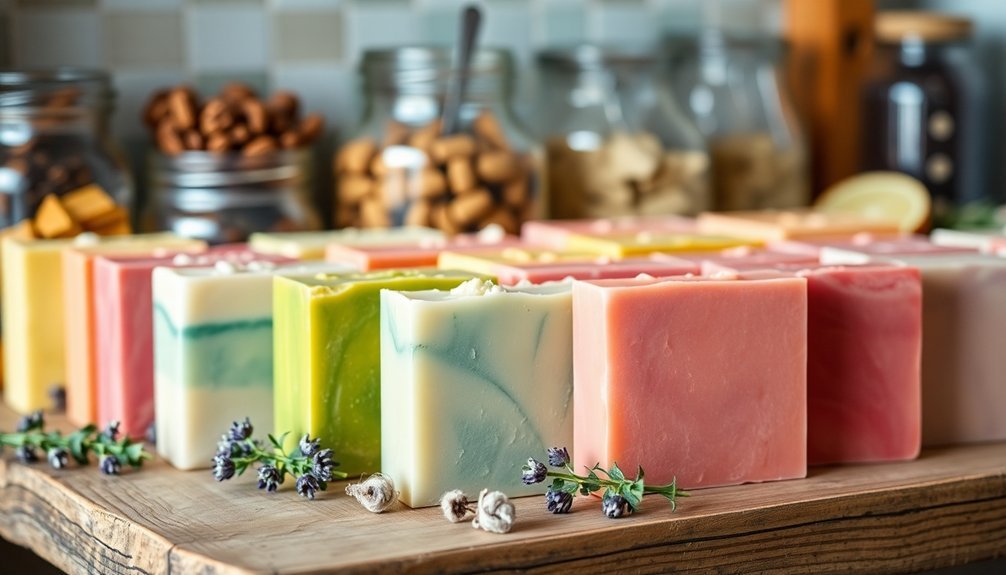
When it comes to preserving the quality of handcrafted chocolate bars, understanding the science behind proper storage is essential. Temperature fluctuations are your chocolate's worst enemy, causing fat bloom—that whitish coating that appears on improperly stored bars.
Proper chocolate storage isn't just fussy perfectionism—it's essential chemistry that prevents unsightly fat bloom and preserves craftsmanship.
Keep relative humidity below 50% to prevent sugar bloom and texture changes. High humidity leads to sugar crystallization on the surface, compromising your chocolate's integrity.
Shield bars from direct sunlight and UV light, which accelerate oxidation and alter both color and flavor.
Don't overlook air circulation—chocolate readily absorbs nearby odors, so store it away from strong-smelling foods.
For maximum longevity, dark and milk-filled chocolates fare best at 6-12°C, while higher temperatures cause noticeable deterioration after just 10 weeks. Consider implementing retemperation processes for your bars, which can increase resistance to bloom formation during storage by enhancing stable form V crystal development.
Temperature Control: Finding the Sweet Spot
Your handcrafted bars will maintain peak quality when stored at temperatures between 65°F to 68°F, protecting heat-sensitive ingredients from degradation.
You'll need to adjust your storage approach seasonally, with extra cooling measures in summer and insulation during winter months. Climate-controlled storage provides an ideal environment for maintaining consistent temperatures year-round, eliminating the need for seasonal adjustments.
Remember that different ingredients in your bars have varying temperature sensitivities, so tailor your storage solutions to the most vulnerable components in your recipe.
Ideal Storage Temperature Range
Finding the perfect temperature range for storing handcrafted bars represents one of the most critical factors in preserving their quality and extending their shelf life.
For ideal results, maintain your handcrafted soap bars between 60°F and 70°F (15°C to 21°C). This range prevents softening while preserving the natural ingredients and fragrances.
Why temperature matters for your handcrafted bars:
- Protection from melting – Temperatures above 70°F can cause your bars to soften and lose their carefully crafted shape.
- Preservation of ingredients – Consistent cool temperatures help maintain the integrity of natural components that make your bars special.
- Extended shelf life – Proper temperature control can double or even triple how long your bars remain fresh and effective.
Avoid temperature fluctuations, as they're particularly damaging to handcrafted products. Storing bars near heat sources like radiators or fireplaces can cause rapid deterioration of quality.
Seasonal Temperature Adjustments
As seasons change throughout the year, so must your storage strategies for handcrafted bars. Your chocolate requires different care approaches across seasons to maintain quality and prevent bloom.
| Season | Temperature | Key Strategy |
|---|---|---|
| Summer | 15-18°C | Use cooling systems, avoid direct light, create temperature zones |
| Winter | 15-20°C | Prevent cold extremes, monitor condensation, guarantee insulation |
| Spring/Fall | 18-20°C | Check conditions daily, make gradual adjustments, use moisture barriers |
During summer, invest in quality cooling units with backup power. In winter, focus on stable, insulated environments rather than refrigeration. For shifting seasons, daily monitoring becomes essential as temperature swings occur. Early detection of any bloom development can help you adjust your storage conditions before quality is compromised. Always keep humidity below 50% year-round, and maintain dark storage conditions to protect your chocolate from temperature-related deterioration.
Heat-Sensitive Ingredients Matter
The chemical composition of chocolate directly influences how it responds to temperature changes, making heat sensitivity a vital factor in storage decisions. Your handcrafted bars contain delicate cocoa butter crystals that begin melting at just 30°C, with milk and white varieties being even more vulnerable due to their lower melting points. Proper temperature control during storage is essential since improperly tempered chocolate often develops white, dusty bloom on the surface.
When storing your premium chocolate creations, remember these vital points:
- Never exceed 120°F (49°C) when handling dark chocolate, and keep milk/white varieties below 110°F (43°C) to prevent permanent texture damage.
- Avoid refrigeration unless absolutely necessary—properly tempered chocolate maintains its quality at cool room temperature.
- Prevent temperature fluctuations which disrupt the crystalline structure, causing unappealing bloom and diminishing your chocolate's luxurious mouthfeel.
Moisture Management for Longer-Lasting Bars
Proper moisture management stands at the core of extending your handcrafted shampoo bar's lifespan. Between uses, make certain your bar dries completely in a well-ventilated area away from direct shower spray. Using a soap dish with drainage prevents the bar from sitting in water, which causes premature dissolving. For optimal preservation, placing your shampoo bars on elevated shelves outside the shower area provides additional protection from excess moisture.
| Storage Tip | Benefit |
|---|---|
| Use draining soap dish | Prevents pooling water |
| Store in ventilated area | Reduces humidity exposure |
| Keep away from shower spray | Prevents unnecessary dissolving |
| Allow complete drying | Extends number of uses |
| Avoid closed containers when wet | Prevents mold and softening |
In humid climates, consider using a dehumidifier or fan to control moisture levels. Remember that properly stored bars can last 50-80 washes, but incorrect storage greatly reduces this lifespan.
Essential Tools for Effective Bar Storage
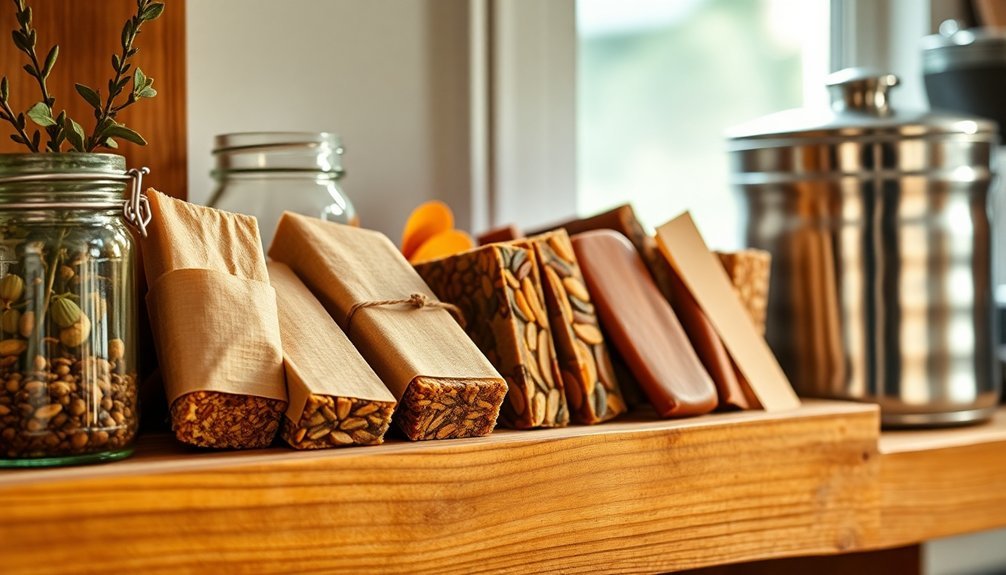
Selecting essential tools for effective bar storage dramatically improves longevity and accessibility of your handcrafted products. Invest in transparent containers that allow you to identify your bars without handling them, reducing unnecessary exposure to air and oils from your skin.
Dedicated shelving systems with proper spacing prevent bars from touching and transferring scents between products.
For ideal organization and preservation, you'll need:
- Vertical organizers – Maximize your storage space while keeping individual bars separated to maintain their distinct aromas.
- Labeled containers – Eliminate confusion and unnecessary handling when you're searching for specific scents.
- Drying racks – Confirm your bars are completely dry before storage to prevent moisture damage and extend their shelf life.
Similar to how a fine mesh strainer provides cleaner filtration for cocktails, using stackable mesh shelving allows proper air circulation around your bars to prevent moisture buildup.
Don't overlook security measures if you're storing valuable artisanal bars.
Seasonal Considerations for Bar Preservation
As seasons change throughout the year, your handcrafted bars require specific attention to maintain their quality and extend their lifespan. Each season presents unique challenges that demand tailored care approaches. Proper seasonal maintenance will protect your outdoor bar from weather-related damage and ensure its longevity.
| Season | Key Preservation Actions |
|---|---|
| Spring | Re-seal wooden surfaces, clean thoroughly, inspect furniture |
| Summer | Wipe surfaces after use, provide shade, check for pests |
| Fall | Deep clean, drain water lines, cover surfaces |
| Winter | Use weatherproof covers, remove snow buildup, store portable items indoors |
| Year-round | Follow maintenance schedule, inspect regularly for repairs |
Travel-Friendly Storage Solutions for Your Bars
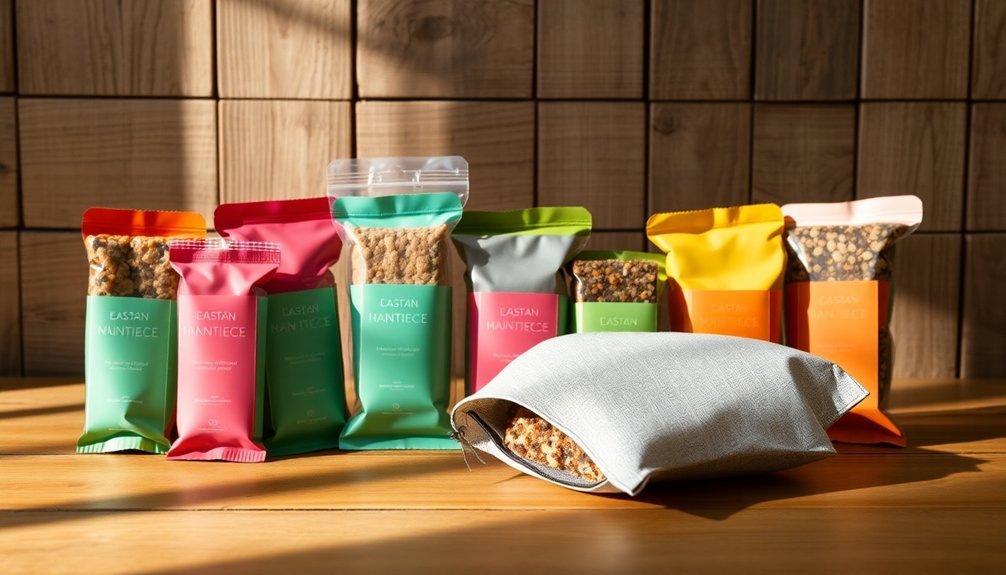
Transporting your handcrafted bars requires specialized storage solutions that balance protection with convenience.
Professional bartenders know that mobility matters: protection and accessibility make the difference between success and stress.
Travel bar backpacks with padded dividers keep your tools secure while providing easy access during events. For maximum portability, consider all-in-one travel kits with dedicated compartments for bottles, shakers, and other essentials.
When selecting your travel storage, prioritize these key features:
- Durable construction – Look for water-resistant materials that withstand frequent handling.
- Secure closures – Prevent embarrassing spills with zippers or clasps that won't unexpectedly open.
- Modular design – Choose systems that can expand or contract based on your specific event needs.
Don't forget about wheeled options for heavier setups. These rolling solutions save your back while allowing quick repositioning at events. Portable mini bars featuring durable caster wheels provide exceptional mobility whether you're hosting indoor gatherings or outdoor parties.
Signs Your Storage Method Needs Improvement
While proper travel storage protects your handcrafted bars on the move, recognizing when your permanent storage methods fall short is equally important.
Watch for physical damage like scratches or dents, which indicate insufficient padding or protection.
You'll need to reassess your approach if you notice warping wood, cracking finishes, or rusting hardware. These structural issues often stem from moisture problems or improper weight distribution.
Fading or discoloration signals harmful UV exposure, while persistent dust accumulation points to ventilation issues. Consider investing in custom wooden signs that indicate storage guidelines to remind yourself and others about proper care techniques.
Don't ignore operational warning signs either. If you're struggling to access your bar or setup requires excessive effort, your storage system is inefficient.
Increasing maintenance frequency or unexpected repair costs are clear indicators that your current storage method is causing long-term damage rather than preserving your investment.
Extending Shelf Life: Advanced Techniques
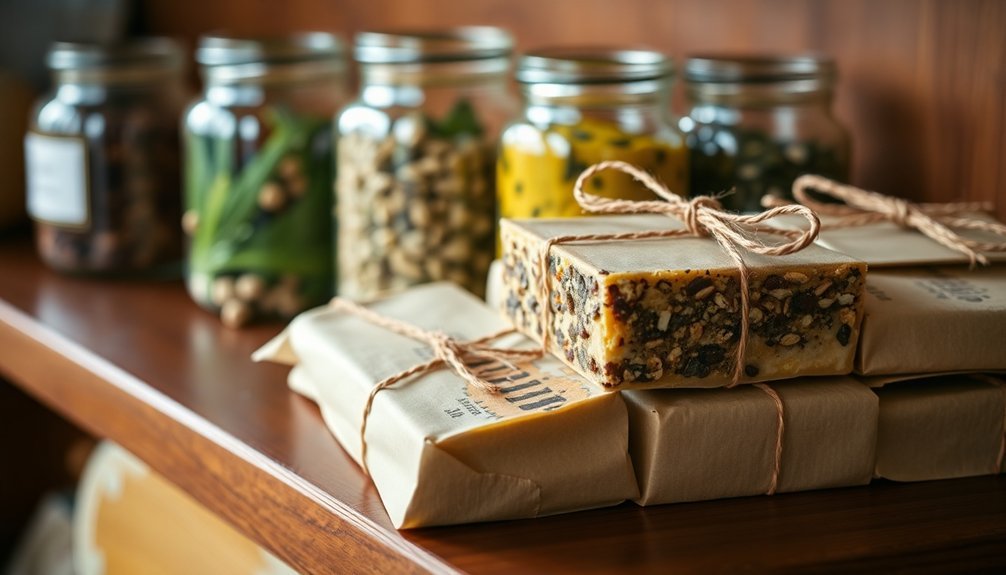
You'll find freeze-drying your homemade energy bars retains flavor while dramatically extending shelf life beyond simple refrigeration.
Pairing this technique with vacuum-sealed packaging creates a powerful preservation system that locks out moisture and oxygen, the primary culprits of staleness.
These methods require some initial investment in equipment, but they'll pay dividends when your bars remain fresh for months rather than days. For optimal results, store your preserved bars in cool, dry places away from direct sunlight to maintain their quality longer.
Freeze-Drying Method
Although relatively uncommon for home preservationists, freeze-drying represents the pinnacle of food preservation technology for handcrafted bars. This sophisticated process removes moisture through sublimation, preserving your bars' original shape, nutrients, and flavors better than conventional dehydration methods.
If you're considering this investment for your handcrafted bars, note these impressive benefits:
- Exceptional longevity – properly stored freeze-dried bars can last up to 25 years, eliminating waste concerns.
- Superior texture retention – your artisanal creations maintain their distinctive mouthfeel and appearance.
- Maximum nutrient preservation – delicate vitamins and compounds remain intact, ensuring your bars deliver intended health benefits. The freeze-drying process preserves approximately 97% of nutrients while removing 98-99% of moisture from your handcrafted bars.
Remember to store your freeze-dried bars in Mylar bags with oxygen absorbers immediately after processing to prevent moisture absorption, which would compromise their extended shelf life.
Vacuum-Sealed Protection
Vacuum-sealed protection represents another powerful method to dramatically extend the shelf life of your handcrafted bars. This technique can increase product longevity by 50% to 400% compared to traditional storage methods by removing oxygen that causes oxidation and spoilage.
For ideal results, invest in quality vacuum sealers like Foodsaver and use thick, protective packaging. The protective foil thickness between 4.5-8 mm provides superior protection compared to standard vacuum bags. Leave adequate space in bags, protect sharp edges to prevent punctures, and always label with production and expiration dates.
The flat surface of vacuum-sealed bars makes them ideal for efficient stacking in limited spaces.
This method isn't just for food preservation—military units rely on vacuum sealing for durable, compact rations in challenging environments. When properly sealed, your bars will maintain their flavor, color, nutritional value, and remain protected from dust, moisture, and pests.
Eco-Friendly Storage Options for Natural Bars
When choosing storage solutions for your handcrafted bars, eco-friendly options provide both environmental benefits and ideal preservation conditions.
Bamboo containers and recycled wood boxes offer sustainable alternatives that naturally regulate humidity while extending your bars' shelf life. For travel convenience, consider cotton or hemp pouches that allow proper air circulation. Our bamboo holders keep your shampoo and conditioner bars perfectly dry through their innovative drainage design.
Embrace bamboo and wood storage that breathes with your bars, or tuck them into natural fiber pouches for sustainable on-the-go protection.
These sustainable choices help your bars and the planet:
- Renewable materials – Bamboo grows rapidly and natural fibers biodegrade, giving you guilt-free storage that won't languish in landfills for centuries.
- Customizable designs – Modular, stackable options maximize your space while adapting to your growing collection.
- Longevity investment – Eco-friendly containers typically last longer than plastic alternatives, saving you money while preserving your handcrafted treasures.
Troubleshooting Common Storage Problems
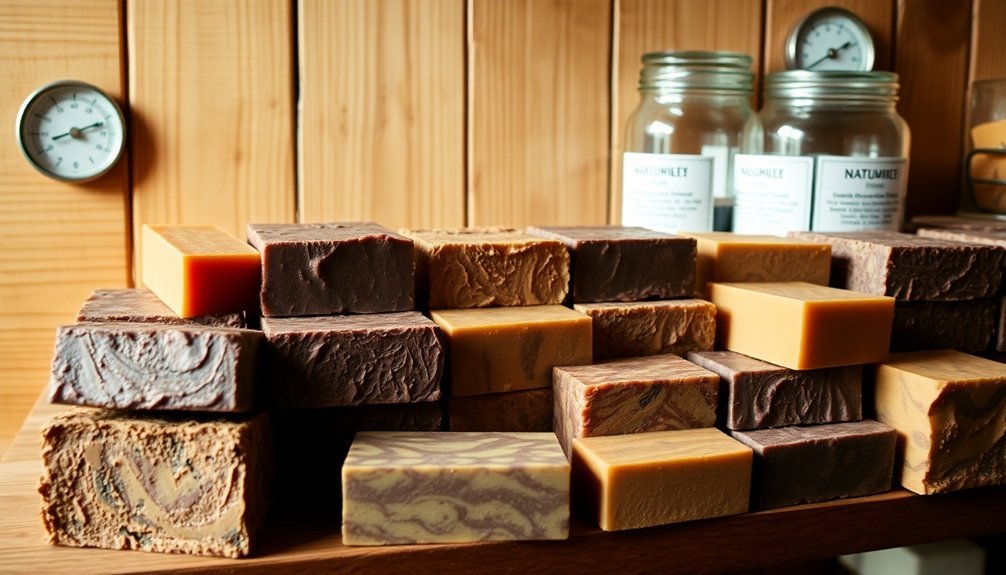
Your handcrafted soap bars might develop mold spots from excess moisture, which you can prevent by storing them in breathable containers with silica gel packets.
Preventing cracked bars requires maintaining consistent temperature and humidity levels while keeping them away from direct sunlight or heat sources.
If your soaps are losing their beautiful fragrances too quickly, try wrapping them in wax paper rather than plastic, which lets them breathe while containing most of the scent molecules.
Soaps stored in areas with poor air circulation can deteriorate faster and develop glycerin dew on their surfaces.
Moldy Bar Solutions
Despite your best storage efforts, mold can occasionally appear on handcrafted bars, requiring prompt attention to salvage your products.
When you spot those telltale signs of discoloration or unusual odors, act immediately to prevent contamination spreading to your entire inventory.
For effective mold removal, try a solution of equal parts white vinegar and water, or sprinkle baking soda and scrub gently with a soft brush. Consider moving affected bars to outdoors when brushing off loose spores to prevent spreading mold throughout your storage area.
Remember to dry thoroughly after cleaning to prevent recurrence.
To prevent future mold issues:
- Maintain indoor humidity between 30-50% using dehumidifiers or proper ventilation
- Include desiccant packets like silica gel in your packaging to absorb excess moisture
- Implement a weekly inspection routine to catch early signs before they become serious problems
Cracked Bar Prevention
Handcrafted bars can develop unsightly cracks if exposed to improper storage conditions, potentially diminishing both their aesthetic appeal and longevity. To prevent this common issue, focus on maintaining stable environmental conditions and proper handling. Humid environments significantly increase the risk of soap cracking due to moisture imbalance in the bar.
| Prevention Strategy | Implementation |
|---|---|
| Control Environment | Store in cool, dry place away from direct sunlight |
| Use Proper Storage | Choose soap dishes with drainage; avoid plastic containers |
| Allow Air Circulation | Wrap in paper, not plastic; guarantee ventilation |
| Handle With Care | Avoid dropping or banging bars; use evenly |
| Consider Ingredients | Balance recipe with proper superfat and temperature |
If cracks do appear, don't worry—your soap remains safe to use. You can repair minor cracks by gently pressing the soap together or store broken pieces in a soap saver bag for continued use.
Fragrance Loss Fixes
When handcrafted soap bars lose their enticing scents, the disappointment can be as profound as the original aromatic experience. To revive and preserve those cherished fragrances, adjust your storage strategy immediately.
Keep your soap in dark, cool places away from direct sunlight, which rapidly degrades essential oils. Choose breathable storage options like mesh pouches or cardboard boxes with airholes rather than airtight containers that trap moisture and accelerate scent fade. Consider rotating your soap bars regularly to ensure thorough drying and maintain their aromatic properties.
For ongoing fragrance preservation:
- Minimize handling to prevent oils from your skin interfering with the soap's natural aroma.
- Maintain stable temperatures and low humidity in your storage area.
- Store citrus and eucalyptus-scented soaps separately, as these volatile essential oils fade faster and may need extra protection.
Frequently Asked Questions
Can I Store Different Types of Bars Together?
No, you should store similar materials together. Keep galvanized bars separate from uncoated ones, and stainless steel away from carbon steel to prevent corrosion. This guarantees your bars maintain their structural integrity over time.
How Does Altitude Affect Bar Storage Requirements?
At higher altitudes, you'll need to be more vigilant about temperature control as lower air pressure causes chocolate to melt easier. Use airtight containers to manage humidity fluctuations that can trigger both fat and sugar bloom.
Do Essential Oil Ingredients Impact Storage Needs?
Yes, essential oils impact your storage needs considerably. You'll need to keep your bars in dark, cool places since these volatile ingredients oxidize quickly. They're sensitive to light, heat, and humidity changes.
Can Refrigeration Extend the Life of Handcrafted Bars?
Yes, refrigeration can extend your handcrafted bars' life by slowing oxidation, controlling moisture, and preventing pathogen growth. You'll maintain better texture, preserve flavors, and greatly increase shelf life with proper cold storage.
Are Vintage Storage Containers Safe for Handcrafted Bars?
Vintage containers can be safe for your handcrafted bars if they're made of food-safe materials. Check for lead-free ceramic, properly coated tin, or glass options that provide airtight seals to maintain freshness.
In Summary
You've now got all the tools you need to store your handcrafted bars properly. Remember, it's the small details—temperature control, moisture management, and seasonal adjustments—that'll extend your bars' shelf life considerably. Don't wait until you notice quality issues; be proactive with your storage approach. With these techniques, you'll enjoy your beautiful creations longer and waste less of your artisanal efforts.

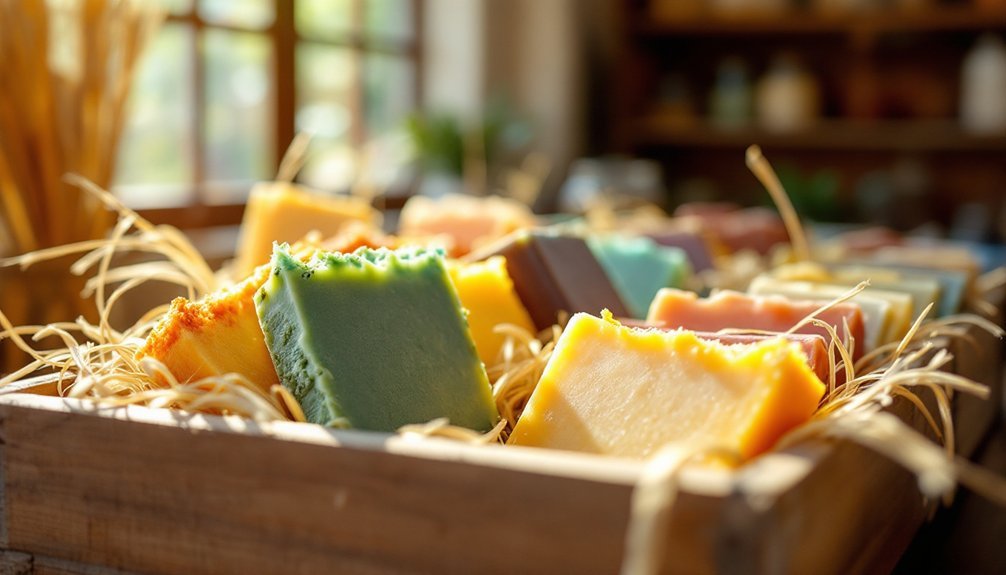



Leave a Reply